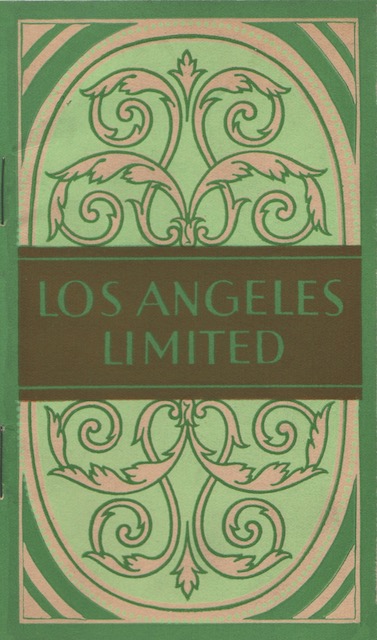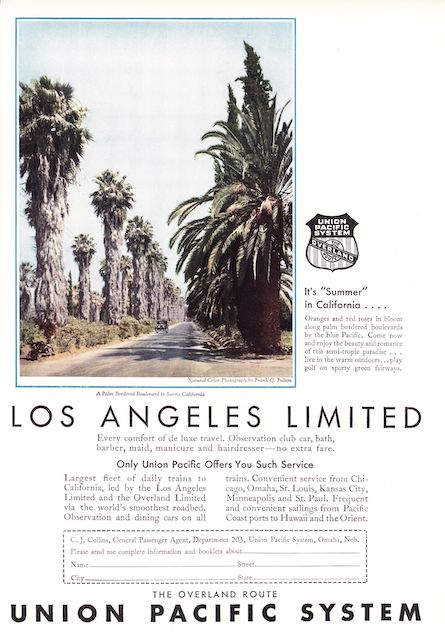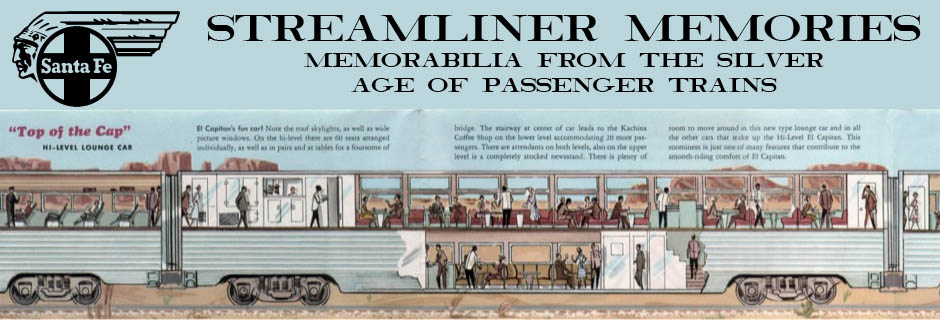Santa Fe’s introduction of the Chief in 1926 led Union Pacific and Rock Island-Southern Pacific to match the Santa Fe train’s 63-hour schedules as well as its extra fares of as much as $10. They also met Santa Fe’s reduction of the schedule to 61 hours in 1928. However, when Santa Fe reduced the Chief‘s schedule to 58 hours in June, 1929, UP and RI-SP were unable to match it so both dropped the extra fares.
 UP used a gold ink in the box surrounding the words “Los Angeles Limited” on the cover of this booklet. However, this is another case of a print color that can’t be digitally reproduced, so it appears brown here. Click image to download a 2.3-MB PDF of this 20-page booklet.
UP used a gold ink in the box surrounding the words “Los Angeles Limited” on the cover of this booklet. However, this is another case of a print color that can’t be digitally reproduced, so it appears brown here. Click image to download a 2.3-MB PDF of this 20-page booklet.
As a result, the opening page of this booklet describing the Los Angeles Limited promises “No extra fare” even though the timetable inside shows a 61-hour schedule that was much faster than any other UP train between Chicago and Los Angeles. By 1933, UP would add coaches to the train, but in 1930 the LA Limited was still an all-Pullman train offering a barber, valet, and a “well-trained colored servant” to provide manicuring and hairdressing services for woman.
“The first inquiry about a train is usually: ‘What kind of an observation car does it have?'” observes this booklet, “for this car is the social center of the community which populates the train.” The answer, in this case, is one with a barber shop and women’s lounge (both of which had showers), two smoking lounges, a small buffet, a “writing room” with two desks, and an observation parlor seating 14 people with an open platform for perhaps 8 more.
Two kinds of sleeping cars were used on the train: one with 12 sections (24 beds) and a drawing room and an all-room sleeper with 7 compartments and two drawing rooms (20 beds). In 1930, the train was as little as seven cars long, including baggage, smoker, diner, observation, and three Pullmans.
Over the flatter portions of the route, including the Chicago & North Western segment, the train would have been pulled by 4-6-2 Pacific locomotives. The C&NW owned the heaviest Pacific-type locomotives ever built that were capable of producing more than 51,500 pounds of tractive effort with 75″ drivers. For its Chicago-Omaha connection with Union Pacific, however, it probably used slightly smaller locomotives with taller (79″) drivers and close to 46,000 pounds of tractive effort.
For the mountain grades in Wyoming, Utah, Nevada, and California, Union Pacific had purchased 4-8-2 Mountain-type locomotives in 1922. These locomotives had 77″ drivers with nearly 55,000 pounds of tractive effort and were capable of pulling an 11-car passenger train up a 0.8 percent grade at 50 miles per hour.
 Click image for a larger view.
Click image for a larger view.
The above 1930 magazine ad suggests that Union Pacific used the exclusive image of the Los Angeles Limited as a sort of “halo train” in order to attract passengers to its other trains. UP had the “largest fleet of daily trains to California,” noted the ad.
In fact, there were seven: in addition to the Los Angeles and Overland limiteds, there were the San Francisco Limited, Gold Coast Limited (which served both L.A. and San Francisco), Continental Limited (which served both L.A. and San Francisco), and Pacific Limited (which served only San Francisco in 1930) from Chicago. In addition, the Pacific Coast Limited connected St. Louis with Los Angeles. By 1932, the San Francisco and Continental limited would be dropped and the Pacific Limited, like the Gold Coast, was split at Ogden to serve both L.A. and San Francisco.
